1 Introduction
In this research, we adopt the broad definition of the
information system (IS) concept described by Gupta (
2013). An IS provides information for the operation, management, decision-making, or control of the enterprise, depending on the level of information needed. So, IS supports different types of decisions at different levels of the organizational hierarchy. In general, most ISs consist of database and information management software components for collecting, storing, processing data, and providing information, knowledge, and digital products. Those components are combined into various types of ISs, such as Enterprise Resource Planning, Decision-Support Systems, Knowledge Management Systems, Transaction Processing Systems, Expert Systems, and Recommendation Systems.
In Computer Science, ontologies effectively represent and integrate knowledge and data (Daradkeh and Tvoroshenko,
2020), extending traditional systems into intelligent systems through their semantic enrichment (Qasim
et al.,
2020). Based on Kalibatienė and Miliauskaitė (
2021b), Kalibatienė and Vasilecas (
2012), in modern ISs, an ontology defines the main concepts, their definitions, relationships between concepts, comprising the vocabulary of an application domain, and axioms expressing complex relationships between concepts. Authors of Verdonck
et al. (
2019) use ontologies for ontology-driven conceptual modelling involving reasoning on the conceptual model contents. The authors of Wand and Weber (
1993) apply ontologies to describe the structure and behaviour of the modelled domain. Another developing direction of using ontologies in ISs is ensuring their security for safe data management and design (Wikström and Mezei,
2014).
To automate the use of ontologies in IS development and application, we need a particular formal language to express an ontology. In literature, formal languages for ontologies are available, such as Ontology Web Language (OWL), which is a standard formal language recommended by W3C for describing ontologies (Curé and Blin,
2015; Wang,
2022). Other available languages are Knowledge Interchange Format (KIF), RDF+RDF(S), and DAML+OIL (Kalibatiene and Vasilecas,
2011). One of the key characteristics of ontologies, which differentiates them from databases, is the ability to make logical deductions (Kokar
et al.,
2009; Saba
et al.,
2021). Authors of Borgo
et al. (
2022) recommended to apply DOLCE as a foundational ontology for modelling cases. The ontological foundation of Conceptual Modelling (the Unified Foundational Ontology (UFO) and the UFO-based modelling language OntoUML) has been successfully employed in a number of different business domains (Fonseca
et al.,
2019). In Amaral and Guizzardi (
2021), authors demonstrated how formal ontology, representing domain knowledge, can be used for knowledge discovery. They briefly elaborate the use of foundational ontologies and ontology-driven conceptual modelling languages in a data mining process.
Authors of Zhang
et al. (
2018) investigate information structures and uncertainty measures in a fully fuzzy IS, in which its attributes are fuzzy. They also stated that the study of information structures and uncertainty measures in a fully fuzzy IS has not been reported deep enough yet. Authors of Daradkeh and Tvoroshenko (
2020), Tvoroshenko
et al. (
2020) recommend using fuzzy ontologies since reality cannot always be clearly expressed. Moreover, fuzzy ontologies allow us to eliminate undefined inaccuracy and conflicting situations when integrating and developing complex systems (Tvoroshenko
et al.,
2020), including ISs for solving multiple structured problems (Daradkeh and Tvoroshenko,
2020). Authors of Carlsson
et al. (
2012) express a fuzzy ontology by introducing a fuzzy relation between concepts and their definitions,
i.e. ontological concepts have a vague meaning but not a tight definition, like in classical ontologies. In Bobillo and Straccia (
2016), authors use fuzzy ontologies described by fuzzy concepts, fuzzy roles, and fuzzy datatypes, to reason on imprecise data.
Summing up, in the related works, we can find different research on either ontology-driven IS (Travé Allepuz
et al.,
2021), fuzzy IS (Gong and Wang,
2017), and fuzzy ontology (Huitzil
et al.,
2020), where either ontologies or fuzzy sets enrich IS with semantic power in different ways and for various purposes. However, the main research question arises: what is obtained by combining three main concepts “ontology”, “fuzzy” and “information system”? In the literature, this phenomenon is reported weakly. So, this paper aims to understand the structure of the ontology and fuzzy IS concept and to grasp its main ideas and results.
Why do we study ontology and fuzzy IS concept? Our answer consists of three main reasons as follows. First, the use of fuzzy theory allows us to extend traditional IS to present not only crisp but also imprecise information. It gives advantages such as increasing the distinction ability of an IS (Li
et al.,
2020), presenting real-world information values under fuzzy attributes in a fuzzy IS (Li
et al.,
2020; Zhang
et al.,
2022), improving the representation of information (Porcel
et al.,
2018; Parida
et al.,
2017; Tabakov
et al.,
2021), better decision-making (Tabakov
et al.,
2021), handling ambiguity and uncertainty of data (Niu
et al.,
2022). Second, the benefits of ontology-based IS have already been proven in plenty of research studies, as these systems have shown their advantages in different IS integration (Ma and Molnár,
2020), conceptual analysis and knowledge representation (Guarino,
1998; Fonseca
et al.,
2019), semantic interoperability using fuzzy ontology (Adel
et al.,
2018), semantic querying of databases (Jain
et al.,
2021). Third, combining “ontology”, “fuzzy”, and “information system” into one concept allows us to inherit all existing and aforementioned advantages and to improve the representation of the real world in artificial systems. So, it is currently important to investigate and understand the newly originated concept of ontology and fuzzy IS. This research increases the body of knowledge on the ontology and fuzzy IS concept by providing a bibliometric analysis with the ontology and fuzzy IS keywords map. Moreover, it presents the spread and future directions of the ontology and fuzzy IS concept. The paper is intended to support academic and industry researchers working on ontology and fuzzy IS, providing them with a comprehensive understanding of the concept and opportunities of its application in practice.
This study is an extension and further development of our previous study (Kalibatienė and Miliauskaitė,
2021b). The previous study did not cover some types of information systems, such as recommendation systems and decision-making systems. In the current study, we do not limit the types of ISs. This extension will provide valuable information on the evolution of ISs and its relationships with other systems. Moreover, we have extended and supplemented the research questions and revised the search period of this research. Consequently, the main contributions of this research are as follows:
-
1. The deeper understanding of the ontology and fuzzy IS concept through developed ontology and fuzzy IS keywords map.
-
2. Presented chronological trends of the research on ontology and fuzzy IS.
-
3. Found main authors contributing to the research on the ontology and fuzzy IS concept.
-
4. Found main countries contributing to the research on the ontology and fuzzy IS concept.
The remaining part of this paper is organized as follows. Section
2 describes related works and reviews, Section
3 introduces the methodology, Section
4 provides the main results, Section
5 presents the discussion, and, finally, conclusions are made in Section
6.
This study is an extension and further development of our previous study (Kalibatienė and Miliauskaitė,
2021b). The previous study did not cover some types of information systems, such as recommendation systems and decision-making systems. In the current study, we do not limit the types of ISs. This extension will provide valuable information on the evolution of ISs and its relationships with other systems. Moreover, we have extended and supplemented the research questions and revised the search period of this research.
4 Main Results
The chronological distribution of papers on ontology and fuzzy IS concept is shown in Fig.
2. The papers were published from 1994 until the end of 2022 (RQ1). As the polynomial trendline (dotted curve) shows, the publication of papers on the analysed topic is increasing, however, fluctuating.
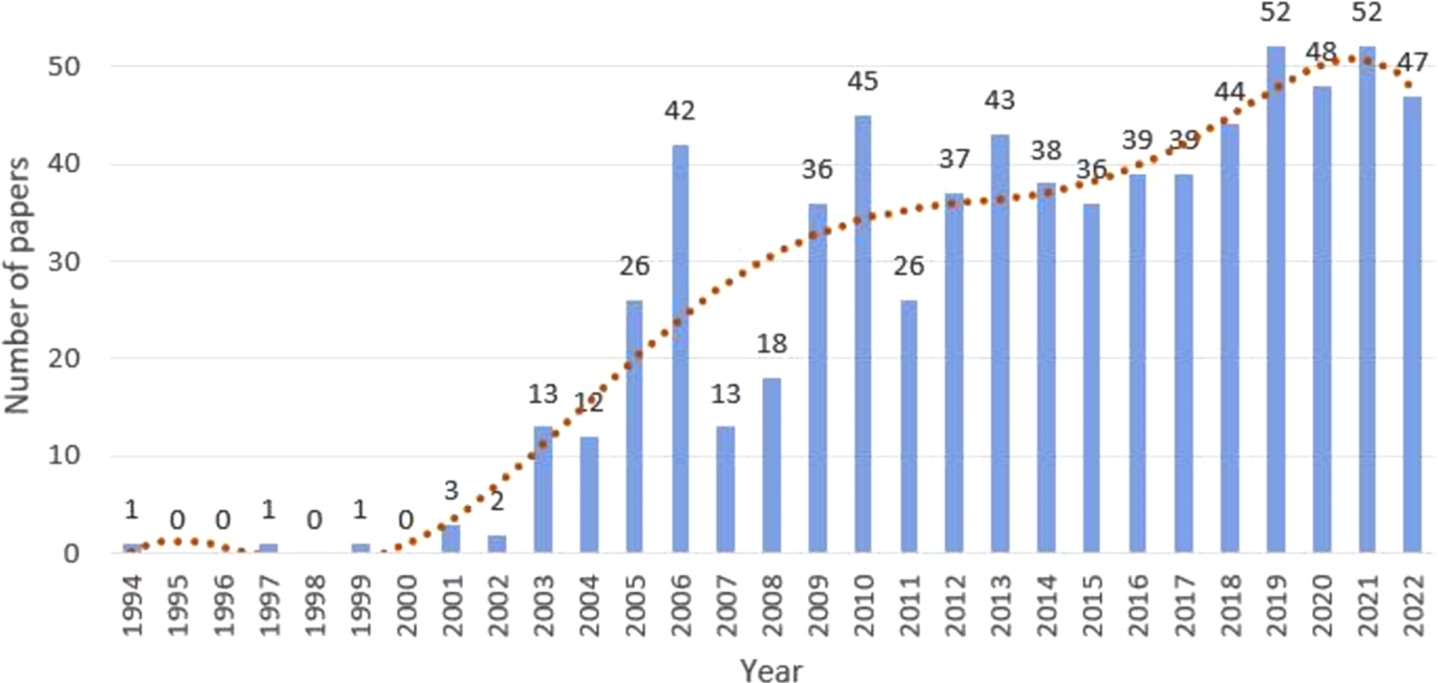
Fig. 2
Chronological distribution of ontology and fuzzy IS concept (RQ1).
The keywords occurrence map according to Average Publication Year (APY) (
i.e. the average publication year of papers that have a particular keyword (van Eck and Waltman,
2019)) is presented in Fig.
3 (RQ2, RQ3). All APY values fall within the year interval of (2008; 2022). The newest yellow-coloured keywords with APY > 2018 are the following: recommendation system (APY = 2020.63, Occur = 8), deep learning (APY = 2020.20, Occur = 5), Internet (APY = 2019.86, Occur = 7), IoT (APY = 2019.86, Occur = 7), sentiment analysis (APY = 2019.06, Occur = 17), Analytical Hierarchy Process (AHP) (APY = 2019, Occur = 6), words (APY = 2019, Occur = 6), semantics (APY = 2018.83, Occur = 6), machine learning (APY = 2018.82, Occur = 12), SPARQL (APY = 2018.8, Occur = 5), reasoner (APY = 2018.7, Occur = 10), and big data (APY = 2018.67, Occur = 6).
The oldest blue-coloured keywords are the following: rough sets (APY = 2008.2, Occur = 5), fuzzy agent (APY = 2008.83, Occur = 6), fuzzy inference (APY = 2008.94, Occur = 16), patterns (APY = 2011.5, Occur = 6), vagueness (APY = 2011.73, Occur = 11), agent (APY = 2011.95, Occur = 22), retrieval (APY = 2012, Occur = 13), interoperability (2012.36, Occur = 11), e-learning (APY = 2012.4, Occur = 5), multi-agent systems (APY = 2012.5, Occur = 6), fuzzy clustering (APY = 2012.75, Occur = 12), knowledge management (APY = 2012.83, Occur = 18), similarity (APY = 2012.96, Occur = 23).
Also, it is found that the keywords can be classified into APY intervals as follows (RQ3):
-
• (2008; 2012] – covers 7% of all found keywords. These keywords include retrieval, agent, vagueness, patterns, fuzzy inference, fuzzy agent, rough sets.
-
• (2012; 2017] – covers 61% of all found keywords. These keywords include type-2 fuzzy ontology, owl, domain ontology, fuzzy reasoning, computing with words, computational intelligence, ontology mapping, fuzzy linguistic modelling, fuzzy markup language, fuzzy ontology, case-based reasoning, information, decision support system, extraction, semantic similarity, data mining, similarity measure, network, database, architecture, ontology integration, knowledge representation, ambient intelligence, decision support systems, semantic web, fuzzy description logics, web, gene ontology, formal concept analysis, user profile, knowledge management, fuzzy clustering, multi-agent systems, e-learning, etc.
-
• (2017; 2022] – covers 32% of all found keywords. These keywords include recommendation system, deep learning, IoT, sentiment analysis, AHP, machine learning, SPARQL, reasoner, big data, features, image retrieval, decision-making, social network, recommender system, expert system, group decision-making, genetic algorithm, wordnet, etc.
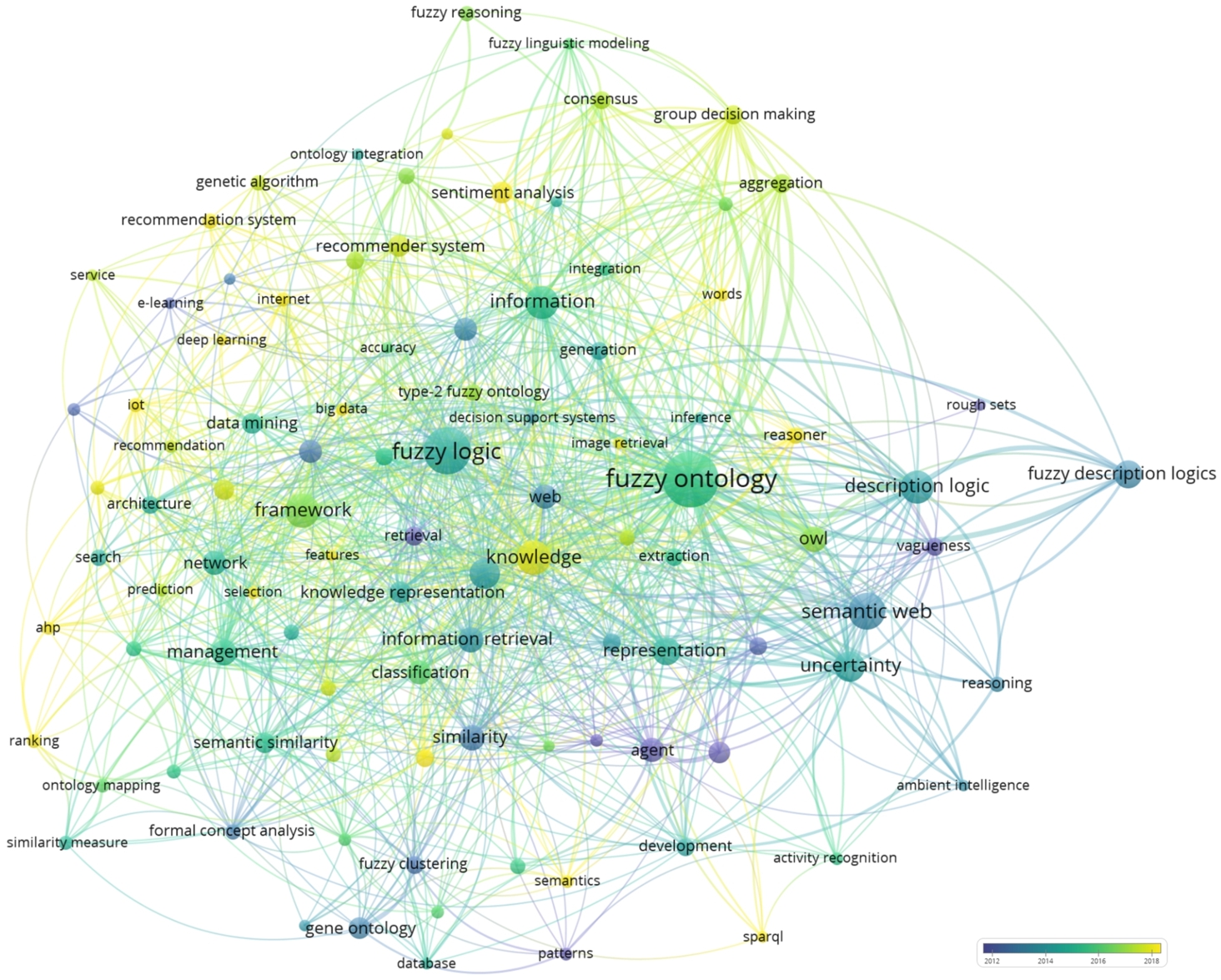
Fig. 3
The keywords map of ontology and fuzzy IS concept according to APY (RQ2, RQ3).
Figure
4 presents emerging topics based on the top keywords in each time slice across the three APY intervals. As can be seen, such topics as ontology and fuzzy ontology remain relevant in all time slices. Other topics, like semantic web, gene ontology, are observed only in two-time slices with changed occurrence. Also, we can see the evolution of some topics, like fuzzy clustering to machine learning, ontology to recommender system, knowledge management to knowledge representation. Another perspective seen from Fig.
3 is related to the size of keyword bubbles, which can be divided into the following intervals (RQ2):
-
• [5; 20]– covers 82% of all keywords. These keywords include fuzzy set, knowledge management, sentiment analysis, recommender system, knowledge representation, gene ontology, fuzzy inference, semantic similarity, data mining, group decision making, machine learning, fuzzy clustering, decision support system, type-2 fuzzy ontology, fuzzy markup language, fuzzy reasoning, IoT, computing with words, big data, fuzzy agent, deep learning, fuzzy linguistic modelling, etc.
-
• (20; 40] – covers 13% of all keywords. These keywords include description logic, fuzzy, fuzzy description logics, information retrieval, OWL, agent, etc.
-
• (40; 60] – covers 3% of all keywords. These keywords include semantic web, knowledge, framework.
-
• (60; 110] – covers 2% of all keywords. These keywords include fuzzy ontology and fuzzy logic.
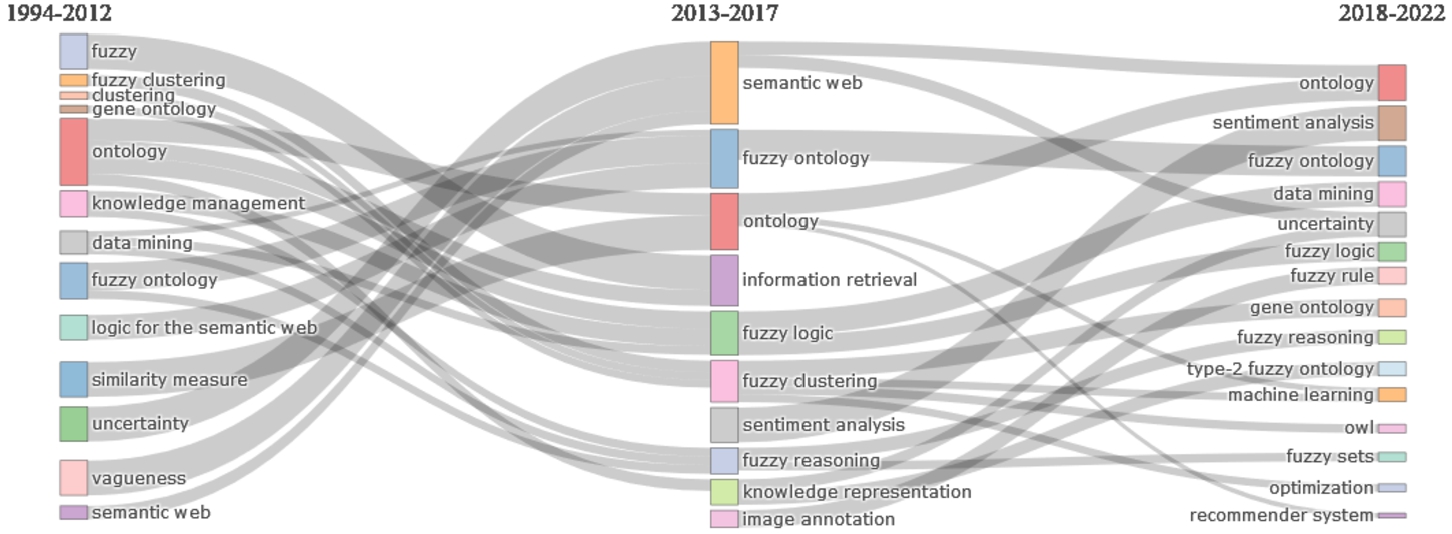
Fig. 4
The emerging topics in time slices (RQ2, RQ3).
Yet another perspective in Fig.
3 is related to links that present the number of papers in which two keywords occur together. Wider lines and shorter distances indicate stronger links between keywords. So, from the ontology and fuzzy IS keyword map (Fig.
3) we have extracted keywords with the strongest links (Fig.
5) (RQ2, RQ3). Here, axes present keywords and bubbles – links with their coloured strengths. Note that this representation is symmetric, but for better visualization, only one part of symmetry is presented.
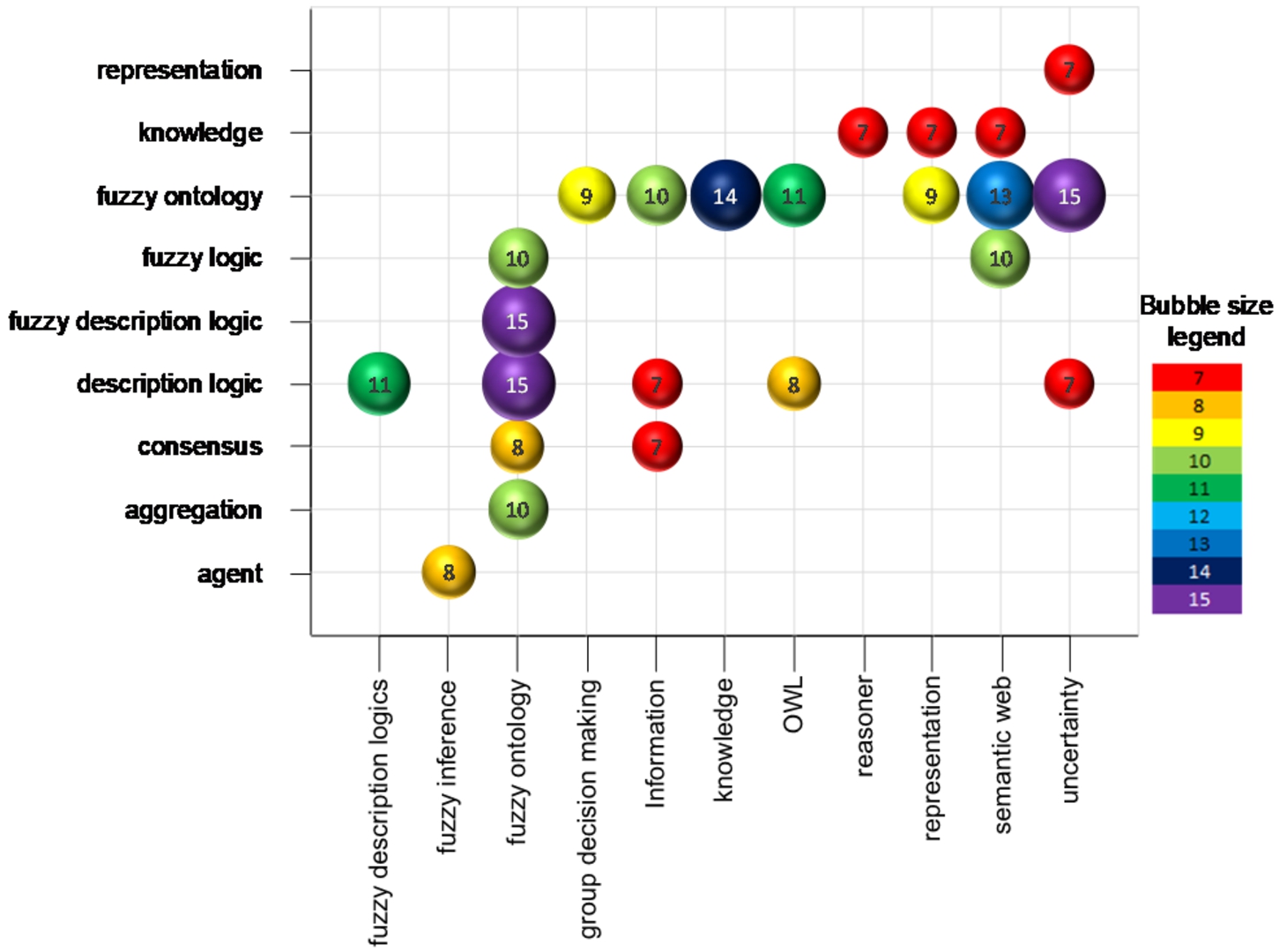
Fig. 5
Ontology and fuzzy IS keywords with the strongest links (RQ2, RQ3).
It is observed that the strongest links with strength 15 (13.04% of the links in Fig.
5) exist between the following pairs: fuzzy ontology – uncertainty, description logic – fuzzy ontology, and fuzzy description logic – fuzzy ontology. Nevertheless, the biggest number of bubbles are those with the lowest strength (7, accounting for 30.43% of the links in Fig.
5), such as representation – uncertainty, knowledge – representation. It can be seen in Fig.
5 that the keyword “fuzzy ontology” is most frequently used with other keywords.
Summing up Fig.
5, in IS, knowledge representation is crucial for knowledge-based reasoning. This is achieved through the use of ontology and fuzzy ontology, and enriching IS with fuzzy ontology, described by OWL and fuzzy description logic.
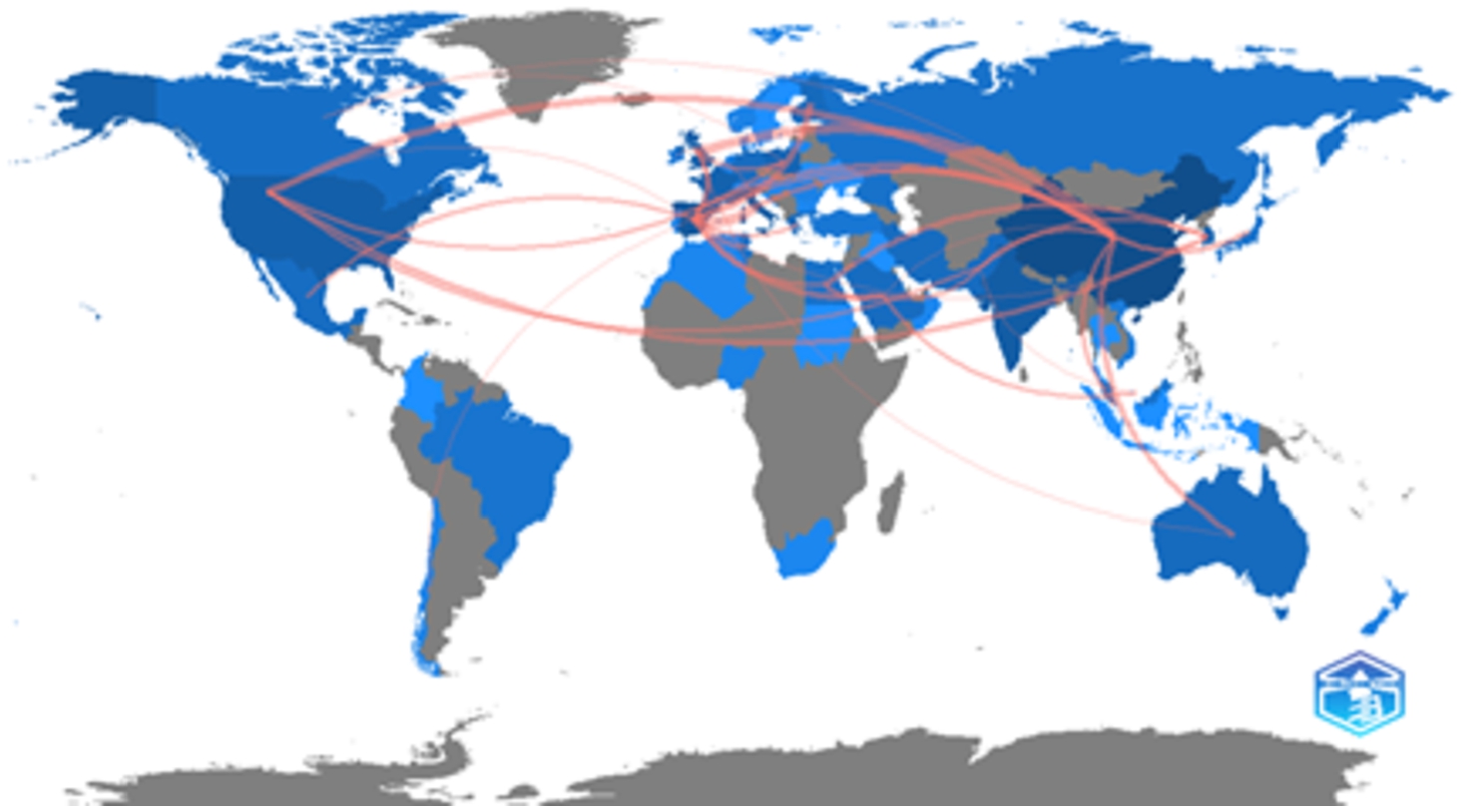
Fig. 6
The countries map on the ontology and fuzzy IS concept (RQ5).
Figure
6 presents the countries’ collaboration map. The intensity of the colours and lines shows the more active collaboration of countries in developing the ontology and fuzzy IS concept (RQ5). The biggest impact on the analysed topic has countries as follows: People’s R China, Spain, Italy, India, Taiwan, USA, England, France, South Korea.

Fig. 7
The authors co-authorship map on the ontology and fuzzy IS concept (RQ4).
The most intensive collaboration is seen between the following countries: Italy – Spain, USA – People’s R China, England – Taiwan, Spain – Finland, Spain – Saudi Arabia. The most various collaboration with other countries is observed in England, Spain, People’s R China, USA, Italy, and Saudi Arabia. Biblioshiny found 25.8% international co-authorship in the analysed papers.
Figure
7 presents the co-authorship map on the ontology and fuzzy IS concept. It shows us the social interactions among authors and their impacts on the development of the ontology and fuzzy IS concept. The most impacting authors who have published more than 10 papers are presented in Table
4. In the last column of the table, the most cited papers of those authors are presented.
Table 4
The most impacting authors according to the number of citations (RQ4).
| Author name |
Documents |
Citations |
APY |
Papers |
| Lee, Chang-Shing |
36 |
1278 |
2011.06 |
(Lee et al., 2007; Lee and Wang, 2010; Lee et al., 2010) |
| Wang, Mei-Hui |
31 |
872 |
2011.93 |
(Lee et al., 2007; Lee and Wang, 2010; Lee et al., 2010) |
| Bobillo, Fernando |
21 |
718 |
2014.00 |
(Bobillo and Straccia, 2008; Bobillo et al., 2009; Bobillo and Straccia, 2011) |
| Straccia, Umberto |
19 |
885 |
2013.95 |
(Bobillo and Straccia, 2008; Bobillo et al., 2009; Lukasiewicz and Straccia, 2008) |
| Herrera-Viedma, Enrique |
15 |
542 |
2017.13 |
(Martinez-Cruz et al., 2015; Morente-Molinera et al., 2017, 2019) |
| Ali, Farman |
8 |
562 |
2017.25 |
(Ali et al., 2018, 2016) |
Table
4 shows the most cited authors. Although Ali, Farman (No. of Documents = 8, No of Citations = 562) is not among the most scientifically productive authors, he is among the most cited authors.
Figure
8 presents the mapping of authors, their cooperating countries, and the main keywords of their research. The colour intensity shows the bigger impact of the author, country, or keyword. The figure illustrates the highest impact of authors from China (People’s R China), Spain, Italy, the United Kingdom, and South Korea which corresponds to Fig.
7. The main keywords found in the presented authors’ papers are as follows: fuzzy ontology, ontology, fuzzy description logic, fuzzy inference, and fuzzy logic.
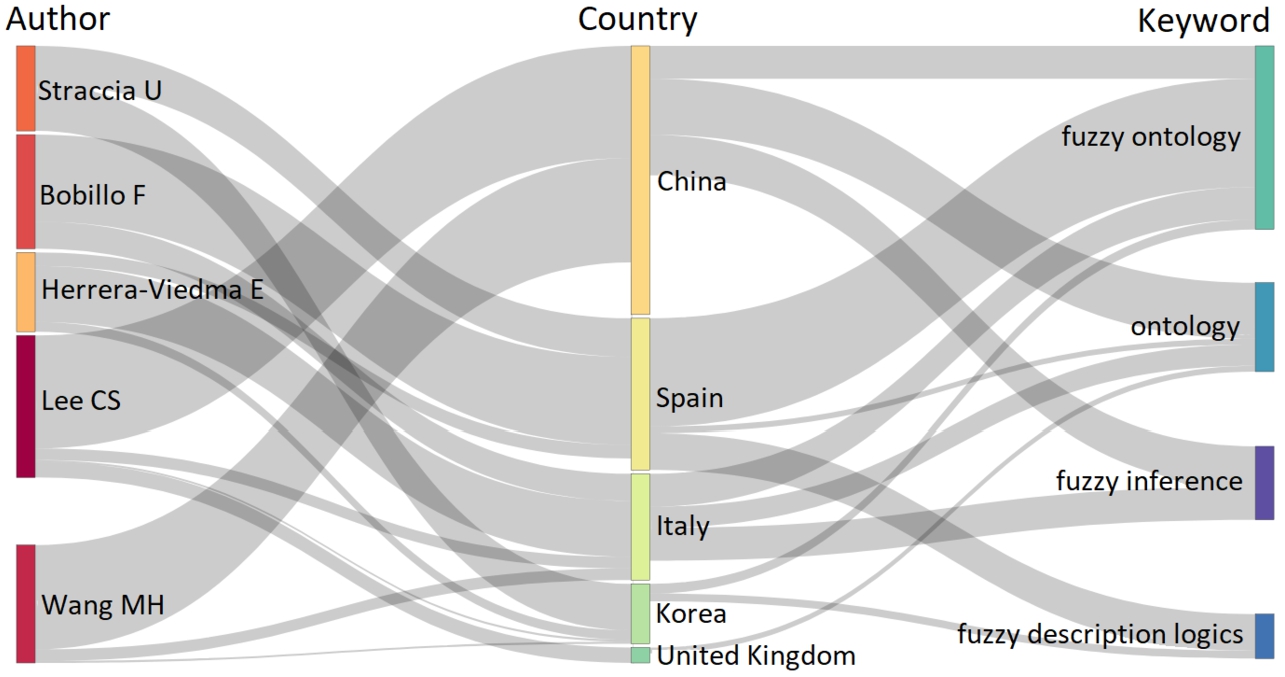
Fig. 8
The authors, countries and keywords co-relationship on the ontology and fuzzy IS concept (RQ4).
Figure
8 highlights the most impacting authors: Lee, CS; Wang, MH; Bobillo, F; Straccia, U; Herrera-Viedma, representing People’s R China, Spain, Italy, United Kingdom and South Korea countries, which mostly work on topics such as fuzzy ontology, ontology, fuzzy description logic, fuzzy inference and fuzzy logic. Summing up, in the context of IS and their application, the main topics of interest are fuzzy ontology, its description with fuzzy description logic, and fuzzy inference.
5 Discussion
In this research, we have presented the results of a bibliometric analysis on the concept of ontology and fuzzy IS. The concept of ontology and fuzzy IS has been analysed in research papers for over 28 years, with consistently active publishing in the last ten years (RQ1).
The analysis of the concept of ontology and fuzzy IS (RQ2) shows that it evolves over time. At the beginning of its analysis (Fig.
3) (time interval (2008; 2012]) the main interest was on agents (e.g. agent-based IS and fuzzy agent-based IS) and fuzzy inference. During the medium time interval (2012; 2017], the following topics exhibited strong development: 1) knowledge management, including formal concept analysis and similarity measure, as well as fuzzy reasoning and case-based reasoning, 2) computational intelligence, including semantic similarity, gene ontology, fuzzy linguistic modelling, computing with words, ambient intelligence, 3) fuzzy ontology and its description with OWL or fuzzy description logics, 4) decision support systems. During the most recent time interval (2017; 2022], the main developing topics are as follows: 1) recommendation systems and prediction based on deep learning; 2) IoT; 3) decision-making; 4) knowledge retrieval from big data, including image retrieval, sentiment analysis, social networks. Thus, we can observe the evolution of IS applications over the years, transitioning from agent-based systems to intelligent reasoning and recommendations driven by machine learning algorithms, marking a shift from theoretical development to sophisticated practical applications (R2, R3).
This research has found that according to the number of publications, Lee, CS, Wang, MH and Bobillo, F are the leading authors contributing to the development of the concept of ontology and fuzzy IS (RQ4). However, the most cited authors are Lee, CS, Straccia, U, and Wang, MH (RQ4). Summing up, the leading authors according to the number of publications and citations in the field of ontology and fuzzy IS remain the same. The leading three countries in researching the concept of ontology and fuzzy IS (RQ5) are People’s R China, Spain, and Italy. Nevertheless, the cooperation among authors and their representing countries is weak enough (25.8%), authors work in closed groups (Fig.
7). So, the cooperation between authors needs to be developed deeper in the future.
In summary, the integration of ontologies and fuzzy theory into traditional ISs leads to the development of intelligent ISs capable of managing fuzzy and semantically rich (ontological) information and ensuring knowledge recognition in various application areas for intelligent reasoning, prediction, and recommendation.
Based on the results of the current research, we have proposed a better understanding of the ontology and fuzzy IS concept, which can encourage further research directions in IS development and application.
5.1 Limitations of the Review
This bibliometric analysis is one of the very few attempts to provide an explanation of the ontology and fuzzy IS concept through its systematic view in scientific papers. Despite the relevance and scope of this study, it has some limitations that need to be clarified here. This will provide valuable insights for defining directions for future research.
This research has a limitation in terms of using a single database. However, as observed in our previous studies Kalibatienė and Miliauskaitė (
2021b,
2021a) and Donthu
et al. (
2021), when using multiple databases, we got a large number of duplicate articles, and their meta-data formats varied across different scientific databases, necessitating additional pre-processing. Moreover, as recommended by Donthu
et al. (
2021), a single scientific database can be used for bibliometric analysis to avoid possible human errors during the aforementioned pre-processing. Since the search in WoS provided us with sufficient and suitable formatted records (719) for bibliometric analysis, we opted for a single scientific database. However, in future works, it would be interesting and possible to extend the bibliometric analysis to other scientific databases.
This bibliometric analysis provides a general view of the ontology and fuzzy IS concept in Computer Science and Engineering. However, a more detailed and comprehensive description and characterization can be achieved through a systematic literature review, which will enable us to reveal additional features of ontology and fuzzy IS.
Furthermore, future studies should adopt various other techniques of bibliometric analysis to gain more valuable insights in this field.
5.2 Lessons Learned
The lessons learned from this bibliometric analysis are related to two main factors: 1) performing a bibliometric analysis itself, and 2) a broader understanding of the concept of ontology and fuzzy IS.
Nowadays, the number of scientific publications is rapidly increasing. Therefore, in order to reveal new trends and summarize existing findings into the state of the intellectual structure of a research topic, researchers have to review a huge number of scientific papers. Therefore, various tools are emerging to support different stages of bibliometric analysis, such as creating keyword co-occurrence maps. However, these tools employ various data processing algorithms that produce different results from the same data. Therefore, when applying a particular bibliometric analysis tool, it is essential to both learn how to use the tool and perceive how its algorithms produce the results.
The current bibliometric analysis offers a broader understanding of the development, applications and limitations of the ontology and fuzzy IS concept. It also uncovers existing research gaps for further explorations and motivates to seek a deeper understanding of the ontology and fuzzy IS concept through a systematic literature review.
It was also observed during the bibliometric analysis that sharing experiences and knowledge among the researchers significantly contributes to the collective development of future research and personal growth.
6 Conclusions
This paper presents the bibliometric analysis on the concept of ontology and fuzzy IS, providing systematization and generalization of the topic and grasping its main ideas.
The chronological analysis of publications on the concept of ontology and fuzzy IS shows the consistent increase of the number of papers in the last ten years, indicating its growing interest and relevance in both science and application.
The analysis of the concept of ontology and fuzzy IS, applying co-occurrence analysis, demonstrates the evolution of this concept over the years from theoretical development to sophisticated applications, including the possibility to collect, save, process, share and reason with fuzzy and ontological information from big data.
Through the analysis of authors’ and countries’ co-occurrence and co-authorship, our research reveals limited cooperation among authors and countries, indicating the need for further development in the future.
The research of ontology and fuzzy IS concept should be continued in order to observe and understand future development trends of the concept and to reveal potential knowledge gaps and issues in intelligent IS applications.

